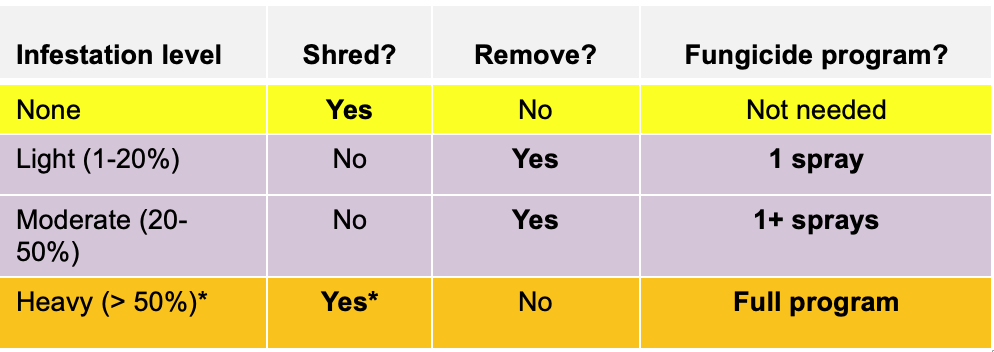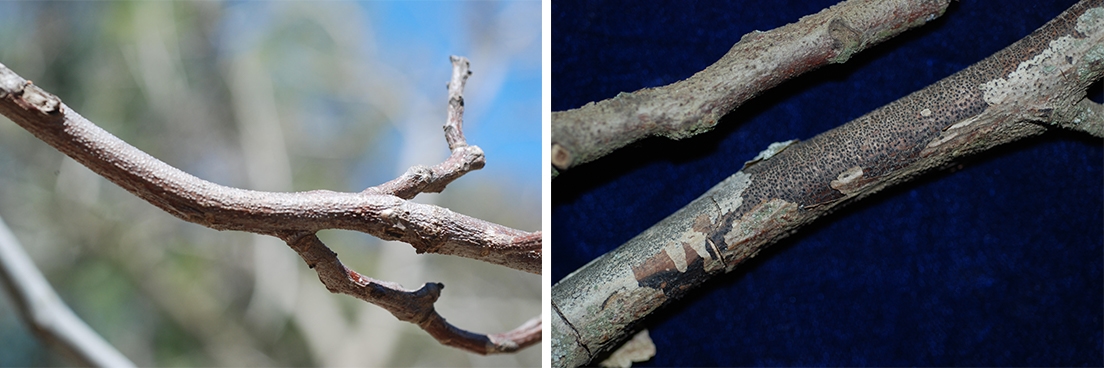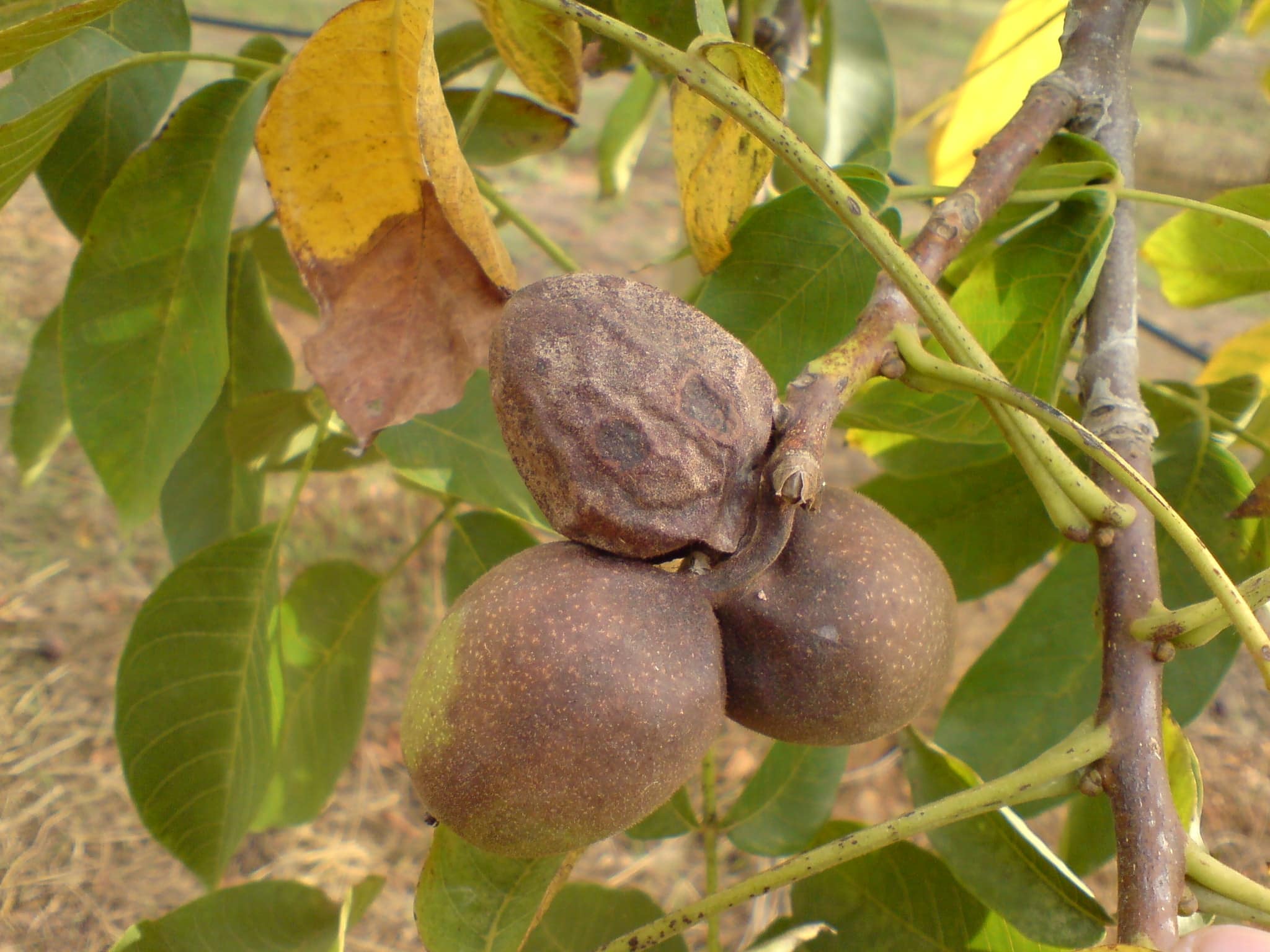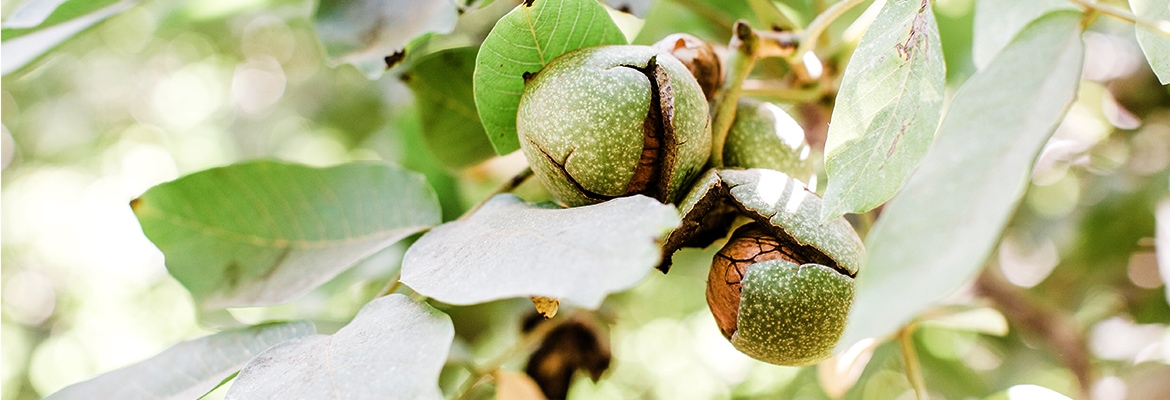Themis Michailides
In the last decade or so, walnut growers started experiencing yield reductions at a time when they expected increasing yields in orchards reaching full production. A close examination of the trees in a number of orchards revealed a plethora of dead spurs and shoots on the trees beyond the normal natural killing of spurs. An even closer observation of these spurs showed pycnidia, which are the spore-producing structures of fungi known as Botryosphaeria(Figure 1) and/or Phomopsis (Figure 2). These fungi cause very destructive canker and blight diseases in crops like almonds and pistachios in California. In addition, the same fungi have been reported from a multitude of crops, representing agricultural, ornamentals, and forest trees and bushes. Although these diseases can kill young trees, they cause fruit and shoot blights and cankers in mature trees.
Research supported by the California Walnut Board from 2014 to 2017 has provided very useful information on how to combat this disease. Research conducted at the Kearney Agricultural Research and Extension Center discovered that ten fungal pathogens in the family of Botryosphaeriaceae and two Phomopsis species can cause blight of walnut fruit and invade and kill spurs with the buds. The killing of the buds, which contain the next year’s crop, can partially explain recently noticed yield reductions.
The pathogens causing Botryosphaeria canker and blight of walnut typically infect green fruit and shoots in the spring when rains occur. These infections do not develop into visible symptoms until late August or September. A brown decay develops on a single fruit, expands to nearby fruits, and then invades the spur killing it (Figure 3). Thus, if left uncontrolled, there will be an excess of dead spurs and shoots accumulated on the trees. All killed tissues are covered with pycnidia, thus there is a tremendous buildup of spore inoculum in the canopy of trees.
Several factors that contribute to the severity of this disease: a) wounds, such as sunburn and hail; b) damage by other diseases, such as walnut blight and downy spot; c) walnut scale feeding injuries predispose shoots to infection; d) frost damage killing the spurs, which are eventually colonized by Botryosphaeria; e) irrigation that wets the tree canopy; and f) environmental conditions, such as a rainfall over ¼ inch and temperatures above 50 ºF. Pruning wounds of walnut remain susceptible to infection for a long time because walnut shoots have a semi-hollow central pith channel. The pith is particularly susceptible to Botryosphaeria, since it absorbs and holds moisture from rainwater longer than woody tissues. Botryosphaeria also grows through the pith faster than it does in woody tissues.
To control the Bot disease, removal of dead branches and shoots is very critical to reduce the amount spore inoculum in the orchard. It is unusual to find dead shoots and spurs from Botryosphaeria or Phomopsis in young orchards unless there is prior damage by frost or walnut scale. Because the canopy of young trees is small, one can easily survey the orchard and remove the few dead shoots that may be found from here and there. This will delay the establishment of the Bot disease in the orchard. If pruning is done in young trees to select and train future scaffold branches, prunings can be shred and left in the orchard.
On older orchards, pruning and fungicide spray-practices to manage Bot disease depend on the disease infestation level (Table 1):
- When the infestation level is up to 20% (meaning 20% of a random sample of 50 killed spurs show pycnidia of Botryosphaeria and/or Phomopsis), or when the infestation is from 20% to close to 50%, then it is advisable to remove pruned branches out of the orchard and burn (if permitted) or compost them. In these cases, one (for light infestation level) or more fungicide sprays (for moderate infestation level) will be needed. The best timing for “one-spray” orchards is in the second part of June to early July. For “two-spray” orchards, apply the first spray in late June to early July, and the second in late July early August – about 1 month later.
- When the orchard is severely infested by Bot disease, prunings can be shred and left in the orchard. Under these conditions, there is a “saturation point” beyond which additional spore loads released by shredded prunings do not cause more infection in the orchard. Furthermore, many pieces of chipped or shredded prunings decompose quickly when left on the orchard floor and do not release many spores. In heavily affected orchards, a full fungicide program consisting of three to four sprays is warranted to help reduce disease levels. For three sprays, the first should be applied in mid-May, the second in mid-June, and the third in mid-July. A fourth spray can be added in mid-April to the above three sprays. While it is not practical nor possible to prune out the numerous blighted spurs and small branches that can be present in heavily infested orchards, , many of these will break off when the trees are shaken at harvest and removed with the nuts during sweeping and hauling out of the orchard. If huller debris is brought back into back to the orchard – to increase organic matter, for example – it it should be composted before returning it to the orchard.
- Regardless of disease infestation level, pruning in the fall (November), rather than in the winter (February) has been shown to result in lower levels of pruning wound.
- When present, controlling walnut scale is also essential in reducing predisposition of shoots to infection by Bot fungi.
Because infection occurs early in the season as latent infections, protection of susceptible tissues in the spring and early summer with fungicides works well in managing Bot. There are many effective fungicides, including strobilurins and carboxamide mixtures (FRAC 7/11), carboxamides and triazoles (7/3), solo triazoles (FRAC 3), and polyphosphate (FRAC 33). For more information and the proper timing of application please visit www.ipm.ucanr.edu/PDF/PMG/fungicideefficacytiming.pdf. As far is currently known, there is no fungicide resistance selection in members of the Botryosphaeriaceae fungi.
Table 1. Brush removal options after pruning of walnut orchards.

* When inoculum on the trees is very high, there is a saturation point beyond which additional spore loads reaching the canopy do not cause more infection.
Figure 1, 2

Figure 3


